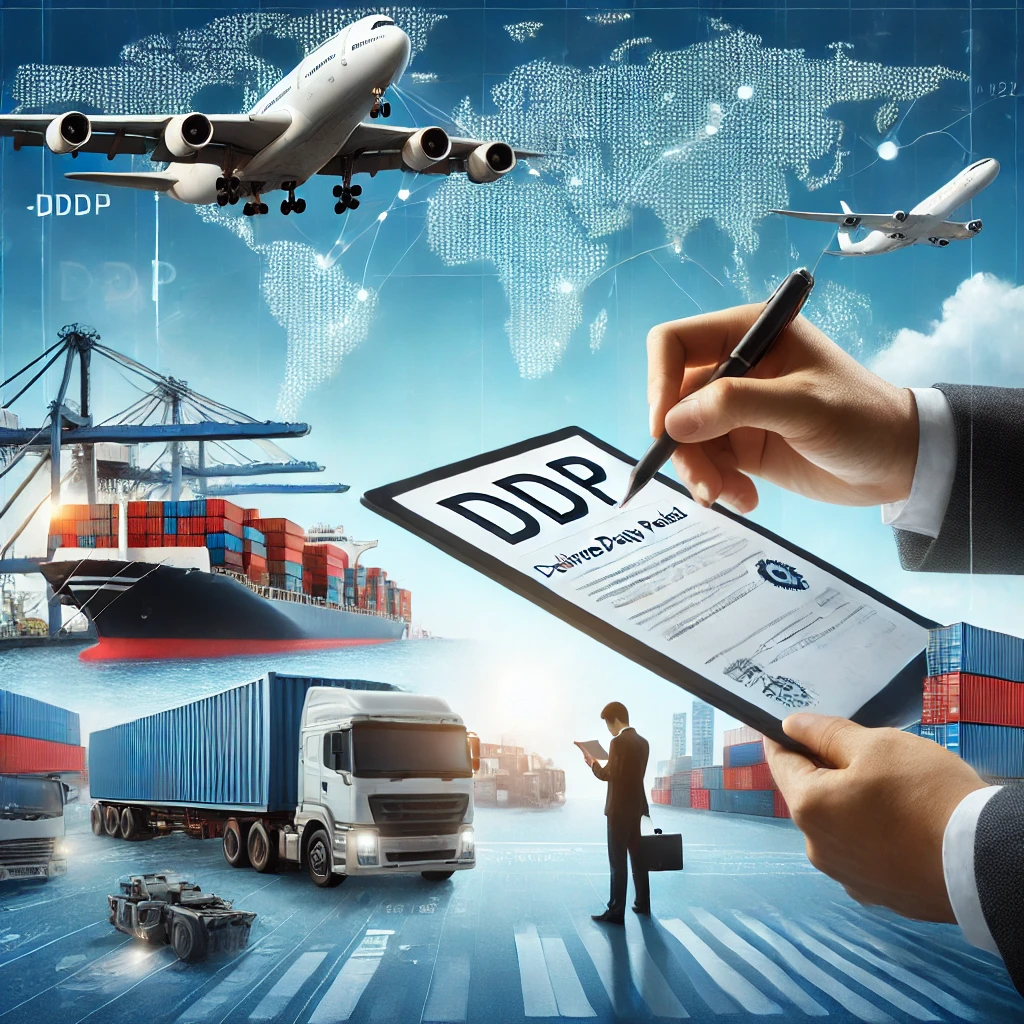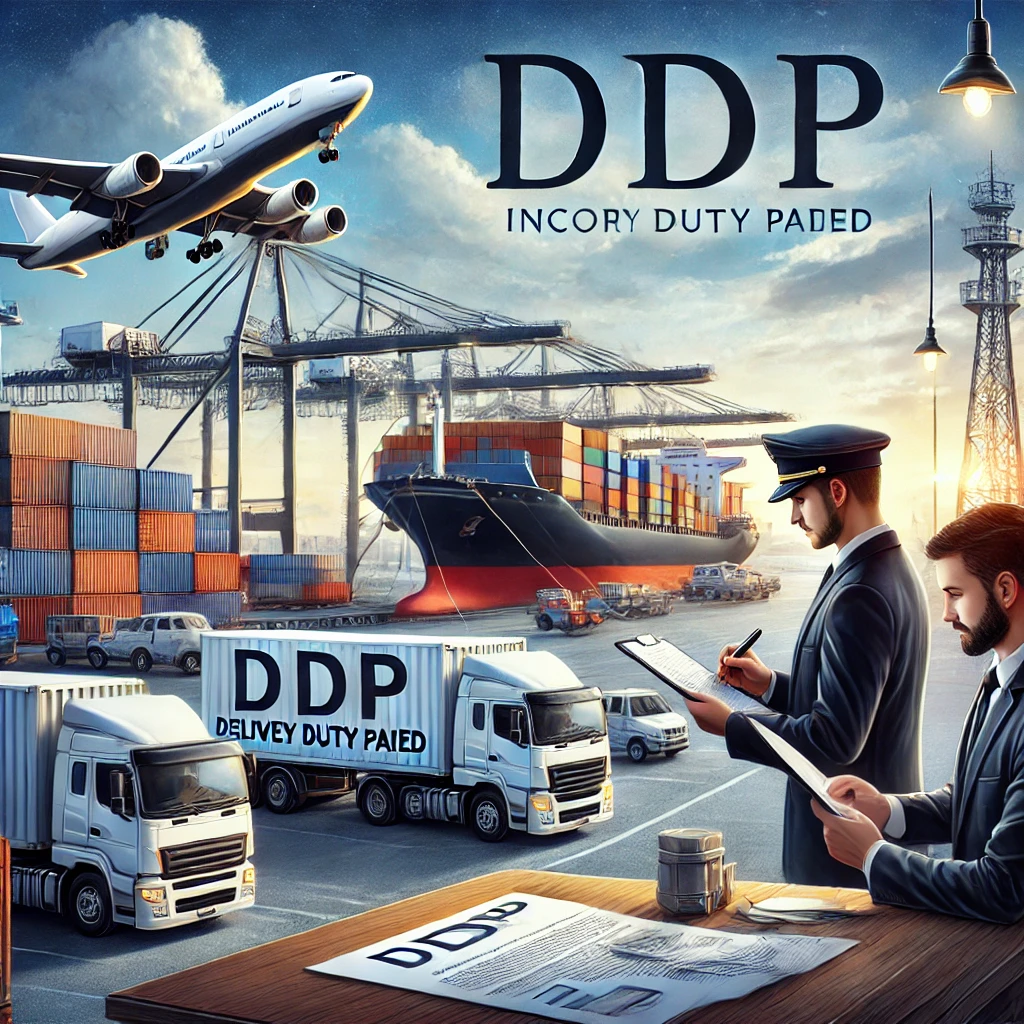An In-Depth Guide to Delivered Duty Paid (DDP)
This article explores the definition, key features, benefits, and practical applications of Delivered Duty Paid (DDP), helping businesses and logistics professionals understand its significance.

What is Delivered Duty Paid (DDP)?
Delivered Duty Paid (DDP) is an Incoterm that places the maximum responsibility on the seller. The seller is accountable for:
- Shipping costs to the final destination.
- Customs duties, taxes, and import clearance in the buyer’s country.
- Risk management until the goods are delivered.
✅ Seller bears all risks and costs until the goods arrive at the buyer’s designated location.
✅ Buyer has minimal obligations except for receiving the goods.
✅ Applies to all transport modes, including air, sea, rail, and road.
Example: A manufacturer in Germany sells machinery to a customer in Canada under DDP terms. The manufacturer covers shipping, customs duties, import clearance, and taxes until the machinery is delivered to the buyer’s warehouse in Canada.
Key Responsibilities in DDP
1. Seller’s Responsibilities
- ✅ Prepares and packages goods for shipping.
- ✅ Arranges transportation from the point of origin to the final destination.
- ✅ Handles export and import customs clearance.
- ✅ Pays import duties and taxes in the buyer’s country.
- ✅ Covers all risks until the goods arrive at the final destination.
2. Buyer’s Responsibilities
- ✅ Receives the goods upon delivery.
- ✅ Ensures accessibility to the final delivery location.
- ❌ Has no liability for import duties or shipping costs.

Key Features of Delivered Duty Paid (DDP)
1. Risk and Cost Allocation
- Seller absorbs most risks (transport, customs, taxes).
- Buyer benefits from hassle-free delivery.
2. Compliance with Import Regulations
- Seller must understand local customs regulations in the buyer’s country.
- Potential delays if incorrect documentation is submitted.
3. Applicable to All Transport Modes
- Works for air, sea, road, and multimodal transport.
- Often used for door-to-door shipping services.
4. Import Duty and Tax Considerations
- Seller must account for VAT, tariffs, and other fees.
- Costs may vary depending on the destination country’s regulations.
Advantages and Disadvantages of DDP
✅ Advantages of DDP
- Buyer-friendly – Minimal risk and responsibility for the buyer.
- Simple and efficient – Reduces administrative burden for the buyer.
- Predictable costs – Seller covers all expenses, ensuring transparency.
- Stronger customer relations – Provides a seamless purchasing experience.
❌ Disadvantages of DDP
- High cost for the seller – Includes all logistics and duty payments.
- Complexity in tax regulations – Seller must comply with foreign customs laws.
- Potential delivery delays – If seller miscalculates taxes or documentation requirements.

Comparing DDP with Other Incoterms
Incoterm | Seller Pays for Shipping? | Seller Covers Import Duties? | Risk Transfers at? |
DDP (Delivered Duty Paid) | ✅ Yes | ✅ Yes | Buyer’s location |
DAP (Delivered at Place) | ✅ Yes | ❌ No | Buyer’s location |
CPT (Carriage Paid To) | ✅ Yes | ❌ No | First carrier |
EXW (Ex Works) | ❌ No | ❌ No | Seller’s premises |
Key Difference: DDP is the most seller-heavy Incoterm, while others transfer costs and risks to the buyer at different stages.
When to Use DDP in Business Transactions
1. E-Commerce and Cross-Border Retail
🛒 Online retailers selling internationally benefit from DDP as it ensures customers receive goods without dealing with customs.
2. High-Value Equipment and Machinery
🏗️ DDP is used for large machinery and industrial equipment, where smooth customs clearance is crucial.
3. Pharmaceuticals and Medical Supplies
💊 Ensures fast, secure delivery of medications and medical devices while complying with import regulations.
4. Corporate Supply Chain and Logistics
📦 Large corporations use DDP to simplify procurement and ensure a smooth supply chain for global operations.

Challenges and Considerations in Using DDP
1. Customs and Tax Compliance
⚠️ Sellers need a clear understanding of import regulations in the buyer’s country.
2. High Operational Costs
💰 DDP is costly for sellers due to logistics, duties, and taxes.
3. Potential Delays
⏳ Import procedures can cause unexpected delays if documentation is not properly handled.
4. Insurance Responsibilities
🚢 DDP does not include insurance, meaning sellers must separately arrange it if required.
Frequently Asked Questions (FAQs)
Q1: Who is responsible for import duties in DDP?
📌 Answer: The seller pays for all import duties, taxes, and customs clearance.
Q2: Does DDP apply to all transportation modes?
📌 Answer: Yes, DDP can be used for air, sea, rail, and road freight.
Q3: What happens if the buyer refuses delivery?
📌 Answer: The seller remains responsible until successful delivery is completed.
Q4: Is insurance included in DDP?
📌 Answer: No, insurance is not mandatory under DDP, but the seller may choose to include it.
Q5: Can the buyer request changes to DDP terms?
📌 Answer: Yes, but both parties must agree to modifications before finalizing the contract.
Conclusion
Delivered Duty Paid (DDP) is a seller-friendly Incoterm that ensures buyers receive goods hassle-free, covering transportation, customs, duties, and taxes. While it offers predictability and convenience for buyers, it places significant costs and administrative duties on sellers.
Businesses using DDP should carefully calculate shipping expenses, understand import regulations, and ensure proper logistics planning to avoid unexpected challenges.
For companies in e-commerce, high-value manufacturing, pharmaceuticals, and global supply chains, DDP can be a valuable tool for expanding international trade and enhancing customer satisfaction.
